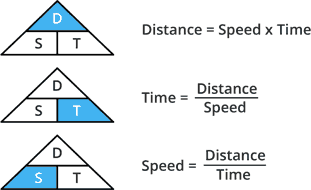Speed measurement with ultrasonic sensor HC-SR04 (Python)
This tutorial guides you through calculating a relative velocity by using the distance measurement of the HC-SR04 sensor over the time.
In order to be able to measure a speed at all, we must first be able to measure a distance to an object. Ultimately, the ultrasonic sensor can do no more. Therefore, first read Distance measurement with ultrasonic sensor HC-SR04 (Python).
Calculating the speed
Let's take another closer look at the triangle from the previous chapter:

So we need
Speed = Distance / Time
However, we do not want to go to the speed of sound now and check whether there is a deviation here.
I will show you how to measure the speed of movement of an object using this sensor. For that purpose we need to take two distance measurements in a short time apart and we have:
distance2 - distance1 = distance speed at a given time
If we make the measurements in a time period of 1 second, then we get the speed of movement of the object in cm/s.
When the object is moving in the opposite direction, the speed represented on the display has a negative sign.
Programming the speed measurement
We change our code from the previous example as follows:
# import libraries
import RPi.GPIO as GPIO
import time
# GPIO Modus (BOARD / BCM)
GPIO.setmode(GPIO.BCM)
# assign GPIO Pins
GPIO_TRIGGER = 18
GPIO_ECHO = 24
# Set direction of GPIO pins (IN --> Input / OUT --> Output)
GPIO.setup(GPIO_TRIGGER, GPIO.OUT)
GPIO.setup(GPIO_ECHO, GPIO.IN)
def distance():
# set trigger to HIGH
GPIO.output(GPIO_TRIGGER, True)
# set trigger after 0.01 ms to LOW
time.sleep(0.00001)
GPIO.output(GPIO_TRIGGER, False)
startTime = time.time()
arrivalTime = time.time()
# store startTime
while GPIO.input(GPIO_ECHO) == 0:
startTime = time.time()
# store arrivalTime
while GPIO.input(GPIO_ECHO) == 1:
arrivalTime = time.time()
# Time difference between start and arrival
timeElapsed = arrivalTime - startTime
# multiply by the speed of sound (34300 cm/s)
# and divide by 2, there and back again
distance = (timeElapsed * 34300) / 2
return distance
def speed():
# calls the distance() function above
distance1 = distance()
# giving a time gap of 1 sec
time.sleep(1)
# calls the distance() function above a second time
distance2 = distance()
# formula change in distance divided by change in time
# as the time gap is 1 sec we divide it by 1.
speed = (distance2 - distance1)/1.0
return speed
if __name__ == '__main__':
try:
while True:
speed = speed()
print ("Measured speed = %.1f cm" % speed)
time.sleep(1)
# When canceling with CTRL+C, resetting
except KeyboardInterrupt:
print("Measurement stopped by user")
GPIO.cleanup()Now that we know what we can measure with the HC-SR04 and how, we can write our driver and wrap it in ROS in the next chapter. Please read for this Writing your HC-SR04 driver (Python).







